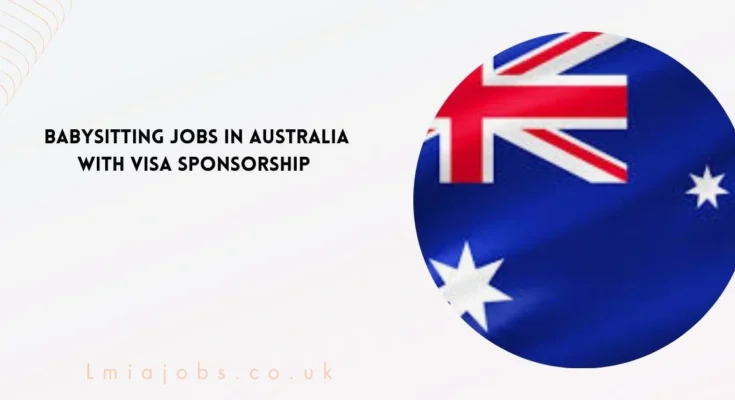There will be a significant labor shortage in Australia. According to JSA’s yearly review, the number of occupations with a shortage of workers increased from 286 in 2023 to 332 in 2024. According to the data, there was a shortage of workers in 36% of occupations during the previous 12 months, compared to 31% in 2022 and 19% in 2021.
If you believe that these jobs are limited to scientific and technological occupations, you should know that this list of jobs also includes many traditional and unskilled jobs, such as housekeepers, food and beverage workers, drivers, and cooks, in addition to nannies and babysitters, of course!
Every criterion and consequence is the same whether you look up how to travel to Australia as a nanny, whether you want to work as a nanny there or bring a nanny with you.
The Temporary Work (Short Stay Activity) Visa (subclass 400) is the one for which you must apply. The nanny may work as your nanny while in Australia for a maximum of three months with this visa; if not, you must check to see if your profession is listed on the Consolidated Skilled Occupations List or the Skilled Occupations List.
What is the difference between a Nanny and a babysitter in Australia?
The length of time they can remain in Australia and their degree of professionalism are the only differences. While a babysitter offers temporary, casual care, typically for three months, a nanny offers continuous, round-the-clock, and permanent care for the kids.
There are a few more formalities, complications, and paperwork involved when a full-time, professional nanny applies for an Australian work visa as an early childhood educator or childhood carer.
Read Also: Visa Sponsorship Field Service Technician Jobs in Australia
Requirements
- Visa Requirements: Temporary Work (Short Stay Activity) Visa (subclass 400)
- The Temporary Work (Short Stay Activity) Visa (subclass 400) is the most common visa used for nannies/babysitters coming to Australia temporarily.
- Duration: The nanny may remain in Australia for a maximum of three months with this visa.
- Application Procedure: The nanny’s employer, who must be a citizen or permanent resident of Australia, submits the visa application on the nanny’s behalf. The person applying for the visa is the nanny.
- “No Further Stay” Condition: The nanny’s visa has a “No Further Stay” condition, meaning that if it expires, they are unable to seek for another visa to stay longer.
- Health and Character standards: As part of the application procedure, both the employer and the nanny must fulfill certain health and character standards.
- Real Temporary Entrant Requirement: The nanny must prove that they truly plan to travel to Australia for a little period of time, go with the employer, and then leave again.
- Proof of Financial Support: In certain situations, the employer might have to provide proof that they have the funds necessary to keep the nanny while they are in Australia.
- The Temporary Work (Short Stay Activity) Visa (subclass 400) is the most common visa used for nannies/babysitters coming to Australia temporarily.
- General Qualifications and Experience
- Experience: Usually, prior childcare or babysitting experience is necessary. Nannies ought to be well-versed in safety, hygiene, and childcare procedures.
- Certification: A Working with Children Check or a First Aid certificate may occasionally be preferred by employers.
- Language Skills: Being able to communicate in English is crucial, particularly if the family speaks the language or needs help educating their kids.
- Employer Responsibilities
- Unless the nanny is self-sufficient, the employer is responsible for covering the nanny’s lodging, transportation, and essential living costs while they are in Australia.
- The employer is in charge of ensuring that the nanny’s employment stays within the parameters of the visa, which include temporary employment and no extensions beyond the first three months.
Job requirements
- You have to be at least eighteen years old.
- The new national criteria set forth by the ANA require nannies and in-home caregivers to:
- Be at least eighteen years old.
- possess a current Working with Children Check and an Australian First Aid and CPR certificate.
- Make a check with the National Police
- Possess at least two up-to-date, reachable references for nannies or daycare
- possess a teaching credential, a Certificate III, a diploma, or be pursuing one while regularly attending pertinent training sessions and seminars.
- Follow the ANA’s code of behavior.
Average Salary
According to our research, which includes thousands of babysitters, the average hourly rate for babysitting in Australia in 2022 is $22.94. This represents an increase over the average hourly rate of $21.74 for babysitting in 2022. However, depending on where you live in Australia, the cost of babysitting differs. It also relies on the variety of tasks and experience a babysitter has.
Benefits
Great Earning Potential
- High Pay Rates: Workers in Australia frequently make more than those in the US, UK, and Ireland, and the country boasts some of the highest average pay in the world. Nannies can anticipate competitive pay, frequently more than twice what they would receive elsewhere, despite the comparatively high cost of living. Despite the increased cost of living, this makes it a financially advantageous proposition.
- Significant Savings: Many nannies discover that they can save a sizeable amount of their income as a result of the greater salary, particularly when contrasted with the earnings in their native countries.
Ample Job Opportunities
- Low Unemployment Rate: With a high demand for competent people, Australia’s unemployment rate is low, at 5.8% as of 2021. This indicates that there are many job openings for nannies and babysitters, particularly for those with suitable childcare expertise. Australia is a safe and stable environment to work since it is simpler for foreigners or recent graduates to get well-paying positions due to the lack of trained personnel in many industries.
Supportive and Flexible Work Environment
- Work-Life Balance: Since most jobs in Australia follow the typical 9–5 schedule, the country’s working culture encourages a great work-life balance. This allows you plenty of time for leisurely pursuits, traveling around Australia, or just unwinding on the weekends.
- Flexible Work Environment: A lot of Australian companies, especially families that use nannies, provide a nurturing workplace where you can pursue a rewarding job while preserving your personal wellbeing.
Enjoy a Laid-Back Lifestyle
- Calm Atmosphere: Australians are renowned for leading a relaxed lifestyle that places a high value on unwinding and having fun. Numerous families reside near beaches and natural areas, which offer the ideal setting for people who appreciate outdoor recreation and a serene setting. A healthy, balanced lifestyle is supported by the Australian work environment and general pace of life.
Access to Excellent Health Benefits
- Medicare System: Australians can receive free medical care in public hospitals and subsidized prescription drugs through Medicare, the country’s top-notch healthcare program. You might qualify for Medicare while you’re there, depending on the sort of visa you have.
- Private Health Insurance: Working vacationers may need to secure private health insurance prior to their arrival in Australia, even though Medicare is accessible. This will guarantee that they have access to complete medical care during their whole stay.
Opportunities for Personal Growth and Travel
- Travel & Exploration: Working in Australia allows you to experience the breathtaking scenery of the nation, including its beaches, rainforests, and even the outback. There are countless opportunities to explore, whether you’re trekking, surfing, or simply lounging in a new city.
- Cultural Exchange: Working as a nanny gives you the opportunity to live in a multicultural community, engage with local families, and learn about other cultures, all of which contribute to your personal development.
How to Apply
Conclusion:
Australia provides nannies and babysitters with excellent work-life balance, competitive remuneration, and job stability. The Temporary Work (Short Stay Activity) Visa (subclass 400) is a great choice if you want to work temporarily in Australia. In a nation where there is a great need for childcare providers, you can land a fulfilling career with credentials like a Working with Children Check and First Aid certification. In addition to the financial advantages, Australia is a great place for anyone looking for work and adventure because of its laid-back culture, plenty of employment options, and easy access to its stunning landscapes.
Frequently Asked Questions
-
What is the Temporary Work (Short Stay Activity) Visa (subclass 400)?
It is a visa for nannies and babysitters who wish to work in Australia temporarily for up to three months.
-
How much can nannies earn in Australia?
In Australia, the average hourly cost for babysitting is $22.94, though this might vary based on experience and area.



